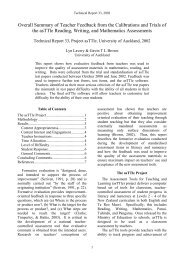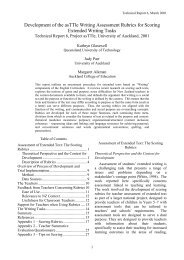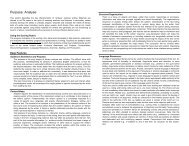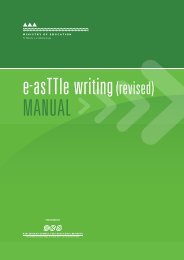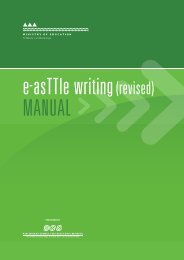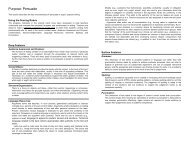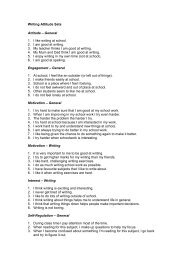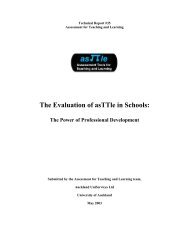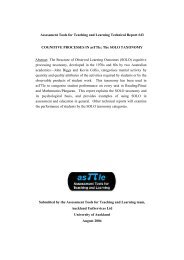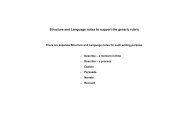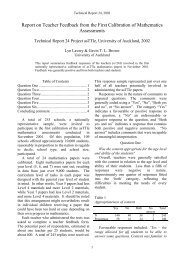11. Maths in the NZ curriculum 2001.pdf - e-asTTle - Te Kete Ipurangi
11. Maths in the NZ curriculum 2001.pdf - e-asTTle - Te Kete Ipurangi
11. Maths in the NZ curriculum 2001.pdf - e-asTTle - Te Kete Ipurangi
You also want an ePaper? Increase the reach of your titles
YUMPU automatically turns print PDFs into web optimized ePapers that Google loves.
<strong>Te</strong>chnical Report 11: Mapp<strong>in</strong>g <strong>the</strong> Ma<strong>the</strong>matics Curriculum 3<br />
This work is supported by professional<br />
development for teachers, and aims to <strong>in</strong>crease<br />
<strong>the</strong> emphasis given to develop<strong>in</strong>g number sense<br />
and computation by promot<strong>in</strong>g mental strategies<br />
and understand<strong>in</strong>g <strong>the</strong>ir emergence.<br />
The Mi<strong>NZ</strong>C statement has directed teachers<br />
to a new way of teach<strong>in</strong>g ma<strong>the</strong>matics. Over<br />
<strong>the</strong> eight years s<strong>in</strong>ce its <strong>in</strong>troduction, it has<br />
become a familiar document to classroom<br />
teachers. Resources and professional<br />
development have been provided to support its<br />
implementation <strong>in</strong> schools. Its effectiveness <strong>in</strong><br />
practice is be<strong>in</strong>g currently considered <strong>in</strong> <strong>the</strong><br />
<strong>curriculum</strong> stocktake process.<br />
The Structure of Mi<strong>NZ</strong>C<br />
The National Education Guidel<strong>in</strong>es<br />
(M<strong>in</strong>istry of Education, 2000), The New<br />
Zealand Curriculum Framework (M<strong>in</strong>istry of<br />
Education, 1993b), and <strong>the</strong> Mi<strong>NZ</strong>C document<br />
all state clearly <strong>the</strong> importance of ma<strong>the</strong>matical<br />
literacy for daily life and <strong>in</strong> <strong>the</strong> world of work.<br />
Ma<strong>the</strong>matics is considered essential to<br />
function<strong>in</strong>g well <strong>in</strong> society, as it contributes to<br />
many daily activities (M<strong>in</strong>istry of Education,<br />
1993b, p. 11). Ma<strong>the</strong>matics taught <strong>in</strong><br />
classrooms should reflect this by us<strong>in</strong>g contextbased,<br />
real-life problems, accord<strong>in</strong>g to <strong>the</strong><br />
<strong>curriculum</strong>. Sense-mak<strong>in</strong>g and effective<br />
problem solv<strong>in</strong>g are key aims.<br />
Ma<strong>the</strong>matics <strong>in</strong> <strong>the</strong> New Zealand Curriculum<br />
divides ma<strong>the</strong>matics <strong>in</strong>to five content strands<br />
and one processes strand. The content strands<br />
are number, geometry, measurement, algebra<br />
and statistics, and probability. The sixth strand<br />
is ma<strong>the</strong>matical processes. This strand <strong>in</strong>cludes<br />
<strong>the</strong> sub-strands of problem solv<strong>in</strong>g,<br />
communicat<strong>in</strong>g ma<strong>the</strong>matical ideas, and logic<br />
and reason<strong>in</strong>g, and is where th<strong>in</strong>k<strong>in</strong>g and<br />
work<strong>in</strong>g “like a ma<strong>the</strong>matician” is taught. This<br />
strand is taught as an <strong>in</strong>tegral part of <strong>the</strong> content<br />
strands.<br />
Each strand has eight levels, except Number<br />
which has six. Each level is designed to cover<br />
two years of school<strong>in</strong>g, although <strong>the</strong> document<br />
shows that children at a given Year may be<br />
work<strong>in</strong>g at a number of levels (Mi<strong>NZ</strong>C,<br />
M<strong>in</strong>istry of Education, 1993a, p. 17). The<br />
strands are each divided <strong>in</strong>to sub-strands, and<br />
objectives are established for each of <strong>the</strong>se substrands.<br />
Examples of learn<strong>in</strong>g activities are<br />
given on <strong>the</strong> pages fac<strong>in</strong>g <strong>the</strong> objectives, and<br />
<strong>the</strong>re are also suggestions for assessment and<br />
extend<strong>in</strong>g children at each level. The objectives<br />
all beg<strong>in</strong> with “with<strong>in</strong> a range of mean<strong>in</strong>gful<br />
contexts, children should be able to...”, referr<strong>in</strong>g<br />
to <strong>the</strong> importance of sense-mak<strong>in</strong>g and<br />
relevance <strong>in</strong> design<strong>in</strong>g ma<strong>the</strong>matics tasks.<br />
The Concept Maps<br />
Two concept maps are presented <strong>in</strong> this<br />
report. A concept map attempts to show<br />
graphically <strong>the</strong> development of ma<strong>the</strong>matical<br />
understand<strong>in</strong>g as it is outl<strong>in</strong>ed by <strong>the</strong> <strong>curriculum</strong><br />
document. These maps do not go beyond <strong>the</strong><br />
<strong>curriculum</strong> <strong>in</strong>to <strong>the</strong> concepts implied by <strong>the</strong><br />
objectives. They order and l<strong>in</strong>k <strong>the</strong> descriptions<br />
given <strong>in</strong> <strong>the</strong> <strong>curriculum</strong> document. At each<br />
level, <strong>the</strong> Mi<strong>NZ</strong>C document provides objectives<br />
that can be clearly l<strong>in</strong>ked to those at <strong>the</strong> next<br />
level. While <strong>the</strong>y vary widely <strong>in</strong> specificity, <strong>the</strong><br />
objectives follow one ano<strong>the</strong>r logically. The<br />
achievement objectives are widely used by<br />
teachers as <strong>the</strong> basis for daily as well as unit<br />
plann<strong>in</strong>g.<br />
The first map condenses <strong>the</strong>se objectives <strong>in</strong>to<br />
an eight-part framework. This map is based on<br />
<strong>the</strong> <strong>curriculum</strong> sub-strands, ra<strong>the</strong>r than on <strong>the</strong><br />
six pr<strong>in</strong>cipal strands. The sub-strands have<br />
been condensed <strong>in</strong>to key <strong>the</strong>mes, and <strong>in</strong> some<br />
cases objectives have been moved from <strong>the</strong><br />
strand <strong>in</strong> which <strong>the</strong>y are found <strong>in</strong> <strong>the</strong><br />
<strong>curriculum</strong>. These changes are described <strong>in</strong><br />
detail below. The objectives are presented by<br />
level, show<strong>in</strong>g how <strong>the</strong>y develop from <strong>the</strong><br />
previous level. In this map, ma<strong>the</strong>matical<br />
process objectives are presumed to be taught<br />
across all eight parts of <strong>the</strong> framework, and are<br />
not listed separately.<br />
The second map reorganises <strong>the</strong> <strong>curriculum</strong><br />
objectives accord<strong>in</strong>g to <strong>the</strong> types of<br />
ma<strong>the</strong>matical activity <strong>the</strong>y imply. Each of <strong>the</strong><br />
six areas is listed with <strong>the</strong> ma<strong>the</strong>matical<br />
processes that perta<strong>in</strong> to each area preced<strong>in</strong>g <strong>the</strong><br />
content objectives. This preserves <strong>the</strong> preem<strong>in</strong>ence<br />
of process objectives, reflect<strong>in</strong>g <strong>the</strong><br />
emphasis <strong>in</strong> <strong>the</strong> <strong>curriculum</strong>.<br />
Writ<strong>in</strong>g a ma<strong>the</strong>matics <strong>curriculum</strong> requires<br />
decisions about what will be <strong>in</strong>cluded, where it<br />
will sit, and how it will be described. There are





